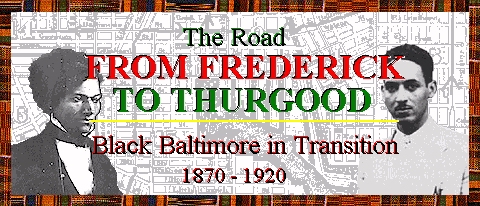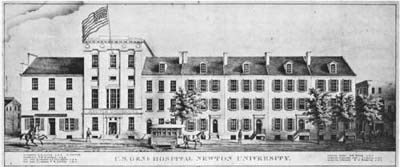 |
210 East Lexington:History |
 |
210 East Lexington:History |

The Civil War era print (above) of the block showing Newton University is well known. The Maryland General Assembly passed an Act of Incorporation in 1845, apparently making Newton the first university in the city. Newton University operated a college and a preparatory school. Advertisements in the Baltimore City Directory show that the school taught languages (classical and modern), natural philosophy, and mathematics. The University was located at 11 East Lexington, the second building on that block. Directory advertisements and Scharf's History of Baltimore date the building to at least 1847. Equity records combined with the act of incorporation show the building was constructed in 1845. By the late 1850's, university president Harlow Heath's health prevented him from properly managing the school. He began bankruptcy proceedings in the Circuit Court while Purley Lovejoy, the principal of the preparatory school, continued to administer classes.
Lovejoy eventually purchased the property and then sold it to the Manufacturer's Bank of Troy, New York, a bank noted for its abolitionist connections. Court records list among the building's subsequent tenants the Baltimore School of Dentistry (which had a dissection laboratory on the top floor) and the Mozart Society (which used the saloon on the second floor, 22 ft. high ceiling, as a concert hall). The one thing the building was never used for was apartments -- it stood across the street from hotel stables! A floor plan of the building was recorded in the chancery case. The Manufacturer's Bank of Troy found its most reliable tenant in the United States Army which operated a general hospital at 11 East Lexington from 1862 through the end of the U.S. Civil War (1861 - 1865). The bank sold the building to Samuel Appold, a notable Baltimore businessman in the tanning industry. Appold transferred it to the Douglass Institute after the war, but long after the Institute started meeting there.
The site's importance has been disguised by the more recent construction of the Vansant Building, but research among original records housed at the Maryland State Archives has revealed the rich heritage of 210 East Lexington.
![]() Return
to "Civil Rights & Politics" Introduction
Return
to "Civil Rights & Politics" Introduction
![]() Return
to The Road From Frederick To Thurgood Introduction
Return
to The Road From Frederick To Thurgood Introduction
|
Tell Us What You Think About the Maryland State Archives Website!
|
© Copyright February 03, 1998 Maryland State Archives